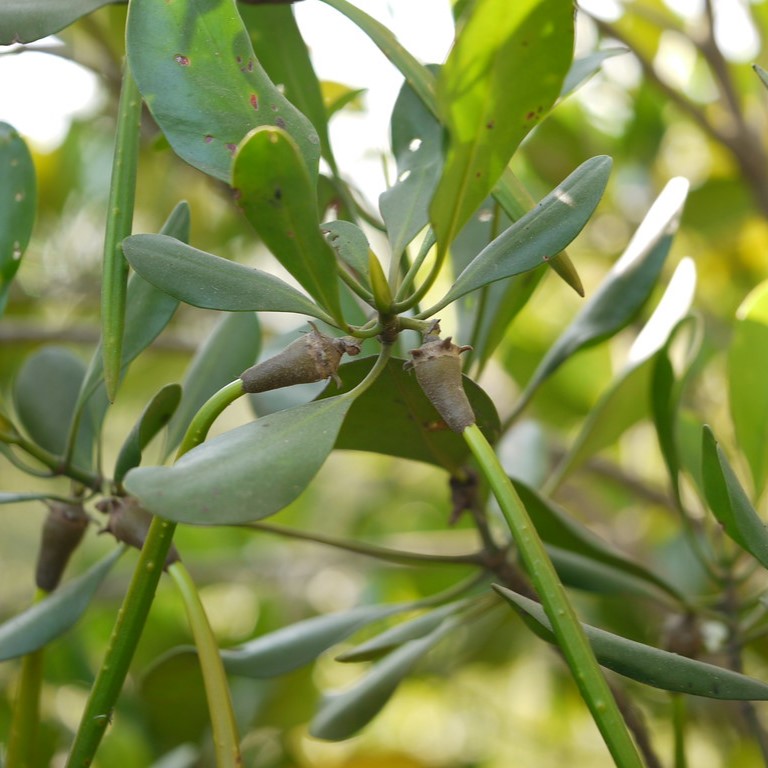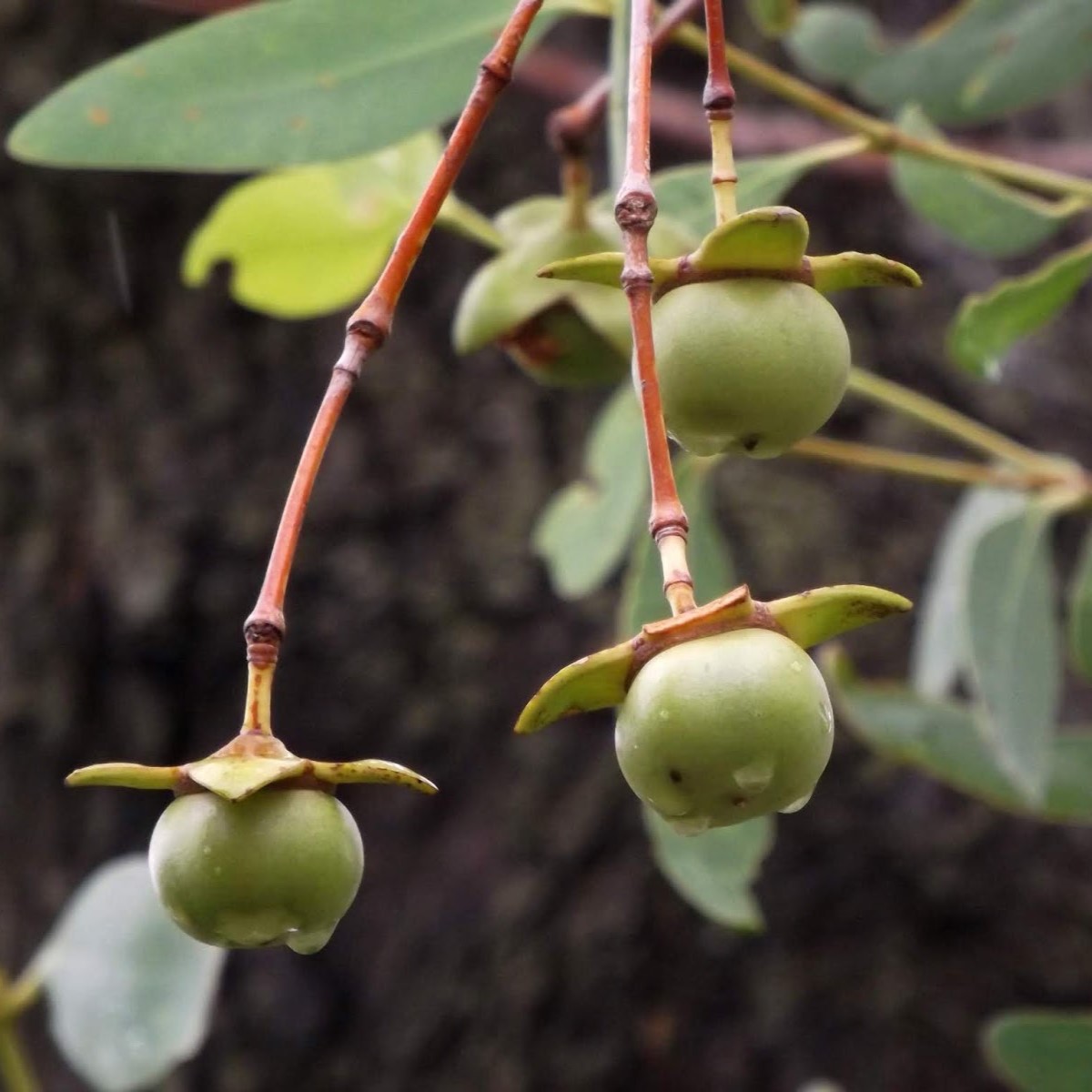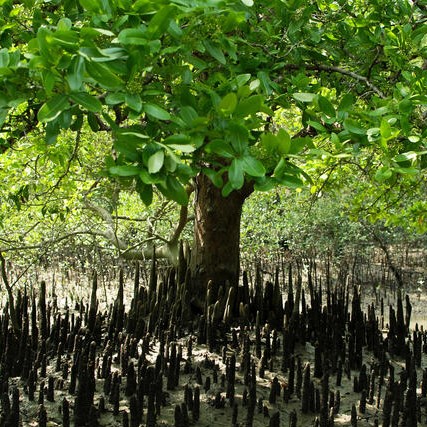Description:
- Ceriops tagal, commonly known as the Asiatic mangrove or Indian mangrove, is a species of mangrove tree in the family Rhizophoraceae. It is found in the intertidal zones of estuaries and along the coastlines of the Indian subcontinent, Southeast Asia, and northern Australia. C. tagal can grow up to 20 meters tall with a trunk diameter of up to 40 centimeters. Its bark is light brown and smooth, with small vertical fissures.
- The leaves are thick, leathery, and elliptical-shaped, with a length of 8 to 12 centimeters and a width of 3 to 5 centimeters. The leaves are dark green on the upper surface and pale green on the lower surface. The tree produces small, yellowish-green flowers that develop into woody fruits that resemble small acorns.
- The fruit has a pointed end and a woody shell, which splits open when mature to release the seedlings. C. tagal is well-adapted to living in brackish water and can tolerate a wide range of salinities. It also has specialized roots, called pneumatophores, that grow above the waterline to allow the tree to exchange gases with the atmosphere.
- C. tagal plays an important role in the ecology of mangrove forests, providing habitat and food for a variety of marine and terrestrial animals. It is also an important resource for local communities who use the wood for construction, fuel, and charcoal production.
Plantation Process;
Here are the general steps for planting Ceriops tagal:
- Site selection: Choose a suitable site for planting Ceriops tagal. It should be in an intertidal zone with saline water, and the soil should be sandy or muddy.
- Propagation: Ceriops tagal can be propagated from seeds or stem cuttings. Seeds should be collected from mature trees and soaked in freshwater for a few hours to remove the pulp. The seeds can then be planted in pots filled with sandy soil and kept moist. Stem cuttings should be taken from mature trees and planted in a mixture of sand and peat moss.
- Nursery care: Seedlings or stem cuttings should be grown in a nursery for several months until they are around 30cm in height. They should be watered regularly and provided with a balanced fertilizer.
- Planting: Once the seedlings or stem cuttings are mature enough, they can be transplanted into the field. Dig a hole in the soil that is deep enough to accommodate the root system of the seedling. The hole should be at a distance of at least 1 meter from other trees. Place the seedling in the hole and fill it with soil.
- Post-planting care: After planting, the seedlings or stem cuttings should be watered regularly for the first few weeks until they establish a strong root system. Weeds should also be removed regularly to prevent competition for nutrients. The trees may also require additional fertilizer and pest control measures.
- Monitoring: The trees should be monitored regularly for growth and health. In the case of any disease or pest attack, appropriate measures should be taken immediately to prevent spread.
It is important to note that planting Ceriops tagal should be done in consultation with local experts and authorities to ensure that it is done in a sustainable and ecologically sound manner.
Plant Care:
Ceriops tagal, commonly known as the mangrove apple or bakhaw in the Philippines, is a species of mangrove tree that grows in brackish water environments.
Here are some caring tips for Ceriops tagal:
- Watering: Mangroves require moist soil, so be sure to water them regularly. However, do not overwater as this can lead to waterlogging and root rot. The frequency of watering depends on the climate and the size of the plant.
- Soil: Mangroves grow in a range of soils, from sandy to clayey. They prefer soils with good drainage, and it's important to avoid soils that are highly alkaline or highly acidic.
- Light: Mangroves require full sun to partial shade to grow optimally. If you are growing mangroves indoors, place them near a window that gets plenty of natural light.
- Fertilizer: Mangroves do not require regular fertilization, as they obtain most of their nutrients from the surrounding environment. However, you can use a slow-release fertilizer occasionally to promote growth.
- Pruning: Mangroves do not require regular pruning, but you can trim off any dead or damaged branches as necessary.
- Pests and diseases: Mangroves are relatively pest and disease-resistant, but they can be susceptible to fungal infections if the soil is too moist. If you notice any signs of disease or insect infestation, treat the plant with an appropriate pesticide or fungicide.
- Transplanting: If you need to transplant your mangrove, do so carefully to avoid damaging the roots. Transplant during the dormant season, and be sure to water the plant regularly after transplanting until it has established itself in its new location.
By following these tips, you can help your Ceriops tagal thrive and grow into a healthy and beautiful tree.
----------------------------------------------------------------------------------------------------------------------------------------------------------------------------------------------------------------------------------------------------------------------------------------------------------------------------------------------------
- Dispatch in 3-5 Days
- Images are for reference purposes only. Actual product may vary in shape or appearance based on climate, age, height. etc. The product is replaceable but not returnable.
- All the plants will be delivered in grow bag and if you want pot (please leave a note and extra charges will be taken for pot).





